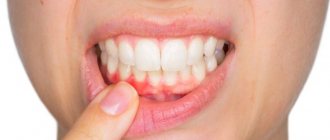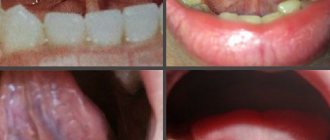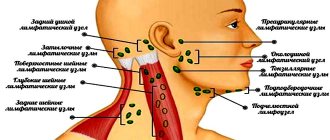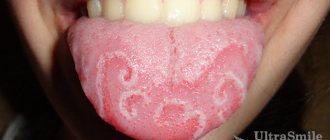The cause of bad breath is not always found in the mouth. Especially when the most common causes, for example, pathology of the oral cavity or stomach, have already been excluded - perhaps the source of the unpleasant odor is located deeper.
It is purulent inflammation that often leads to the formation of a “bad” odor. If it is in the mouth, the cause is usually discovered quickly. On the other hand, in the case of inflammation outside the mouth, additional diagnostics may be required to find the cause of bad breath.
Bad breath
The content of the article
Bad breath (stench ex ore, halitosis) is the first symptom of diseases of the gastrointestinal tract. In approximately 90% of cases, the unwanted odor comes directly from the mouth; in the rest, the source of the odor is other parts of the gastrointestinal tract.
The causes of bad breath are multifactorial:
- diseases of the upper gastrointestinal tract;
- respiratory system;
- some systemic diseases;
- metabolic disorders;
- taking medications;
- malignant tumors.
An unpleasant odor is most often the result of the action of bacteria that break down organic substances present in saliva, exfoliated epithelium and food debris. The main products of this decomposition are volatile sulfur compounds. Normal oral flora consists of gram (+) and gram (-) granulomas and bacilli. The source of bad breath most often is the waste products of gram (-) anaerobes.
A breakthrough in research on this issue occurred in 1934, when scientists designed an osmoscope that allowed a semi-quantitative assessment of odor intensity. In the 1970s, gas chromatography was used to identify VSC as the main cause of odor.
The identified compounds are:
- hydrogen sulfide (H 2 S);
- methanethiol - methyl mercaptan (CH 3 SH);
- dimethyl sulfide (CH 3 SCH 3).
Today, halimeters are used to assess the presence and concentration of volatile sulfur compounds in exhaled air. Gastroenterologists also have a test that determines the activity of enzymes in saliva, which proves the presence of bacteria that produce volatile sulfur compounds.
Other causes of bad breath include: smoking, drinking alcohol and drinking coffee. In these cases, it is easy to determine the cause of bad breath.
Bad breath due to oral diseases
Bad breath in diseases of the oral cavity
Causes of bad breath in diseases of the oral cavity:
- coating on the tongue;
- periodontal disease (including tissue around implants);
- widespread caries;
- ulcers in the mucous membrane;
- food debris between teeth and in gum pockets;
- uncleaned teeth and dentures;
- the contents of the cysts flowing into the oral cavity through the fistula;
- cancerous lesions of the oral cavity;
- factors that reduce saliva production.
The most common source of unpleasant odor is the layer that covers the top of the tongue. It consists of thickened saliva, bacteria, exfoliated epithelium and food debris. The smell intensifies with anatomical defects of the tongue - cracks and cuts, ulcerations on the tongue, hairy tongue. Improper use of a brush when cleaning the tongue leads to the formation of ulcers.
Features of the development of the disease
The feeling of a rotten, purulent odor in the nasopharynx in most cases develops when the body's immune system fails to cope with its protective functions. This leads to the active proliferation of pathogenic bacteria in the nasopharynx and the appearance of a putrid odor. The following general reasons for the appearance of a stale odor in the nasopharynx are distinguished:
- The course of the disease is acute.
- Development of secondary diseases of internal organs and systems. In this case, a bad smell will be one of the main symptoms.
- Bad smell as the main manifestation of the disease.
The most common causes of odor are chronic diseases of the nose and throat.
Bad breath in ENT diseases
Patients with ear, nose, or throat diseases often complain of bad breath. Reasons include:
- viral and bacterial pharyngitis;
- tonsillitis;
- deep crypts in the tonsils;
- sinusitis of the nose;
- foreign bodies in the nasal cavity or sinuses;
- nasal discharge with an unpleasant odor.
Due to difficulty in nasal breathing, the oral cavity dries out, which accelerates the detachment of the epithelium and the formation of plaque on the tongue.
2. Reasons
The documented history of the study of ozena, confirmed by archaeological finds, goes back more than three and a half thousand years, but the etiopathogenesis remains unclear to this day. Among the many assumptions put forward and discussed, the following hypotheses dominate:
- infectious (in 80-90% of patients, a coccal, capsule-forming, antibiotic-resistant bacterial culture of the genus Klebsiella is sown, which was given the subspecies name Klebsiella pneumoniae ozaenae, i.e. Klebsiella pneumoniae ozaenae); However, the origin of ozena remains unclear in cases where Klebsiella is absent;
- genetic (features of the genome can explain, in particular, the endemicity and ethnic dependence of the incidence);
- endocrine (the predominance of women is explained, but other aspects do not fit into the dishormonal concept);
- neurodystrophic (according to which deep dystrophy and then atrophy are caused by disturbances in tissue nutrition and conductivity of the peripheral branches of the facial nerve);
- anatomical (the atrophic process is explained by anomalies or infantility in the structure of the paranasal sinuses and other nasal or paranasal structures);
- pathophysiological (ozena is considered as a complication or long-term consequence of frequent, acute, chronic inflammations - nasopharyngitis, laryngitis, etc.).
The main risk factors are hypovitaminosis, nasal injuries, diseases of the autonomic nervous system, smoking, industrial and environmental hazards.
Visit our Otolaryngology (ENT) page
Bad breath due to gastrointestinal diseases
Bad breath in gastrointestinal diseases
Halitosis can be caused by diseases of the digestive tract, in which bacterial flora producing volatile sulfur compounds develops on the remains of dead tissue (for example, on the edges of ulcers), blood clots and food debris. Common pathologies:
- Gastroesophageal reflux disease (GERD);
- Zenker's diverticulum;
- Achalasia of the esophagus;
- Gastritis;
- Peptic ulcer;
- Tumors of the esophagus;
- Stomach cancer;
- Diseases in which there is an overproduction of volatile compounds with odor;
- Intestinal malabsorption syndromes (associated with excessive gas formation in the intestines);
- Liver failure associated with the accumulation of ammonia and other breakdown products of amino acids, causing an unpleasant odor, especially intense in hepatic encephalopathy.
The existence of halitosis caused by H. pylori infection is a controversial issue.
Other causes of bad breath
Other causes of bad breath include:
- Chronic kidney disease (most often the result of glomerulonephritis), during which the concentration of urea in the blood increases. The exhaled air smells of ammonia, the patient has a salty taste in the mouth;
- Improperly treated diabetes, leading to the accumulation of ketone compounds, giving the exhaled air the characteristic smell of acetone. Diabetes often presents with dry mouth;
- Trimethylaminuria (fish odor syndrome) is a genetically determined metabolic disease that disrupts the oxidative pathway of trimethylamine in the liver. Excessive amounts of trimethylamine in the exhaled air cause bad breath.
Diagnosis of bad oral odor
Diagnosis of bad breath
Bad breath leaves many unpleasant moments for the patient and the people around him. Therefore, when a smell appears in the mouth, patients first resort to unconventional methods of control, which include enhanced oral hygiene. And only when these methods do not produce results do they turn to a gastroenterologist for help.
Diagnosis of bad breath is a prerequisite for successful treatment of bad breath. The doctor begins with a thorough history and physical examination. Particular attention is paid to:
- rules of oral hygiene);
- the moment and circumstances associated with the occurrence of bad breath;
- dietary habits;
- condition of the oral cavity;
- respiratory symptoms.
Treatment options
To get rid of the smell, you need to find out the cause of its appearance.
The method of treating such a condition largely depends on the specific cause of the disease, its form, neglect, as well as the presence of concomitant pathologies in the patient.
Today, three main treatment methods are practiced: drug therapy, surgery, and folk remedies. The selection of treatment measures should be carried out exclusively by the attending physician. Self-medication in this condition is unacceptable.
Classic drug therapy involves the use of the following drugs:
- For bacteriological damage, antibiotics are used.
- Prescription of analgesics and antispasmodics (No-Shpa).
- Rinse the nasal cavity with saline solution and hydrogen peroxide.
- Installation of turundas soaked in medicinal solutions.
- Rinse the nose with a solution of sea salt.
UHF therapy and electrophoresis are used as physiotherapy procedures.
Important! If the root cause of the disease is systemic diseases of the internal organs, the main treatment should be aimed at eliminating them. Only by curing the source of the disease will it be possible to get rid of the symptoms that it provokes.
Most likely you need to contact an ENT specialist.
Different specialists can treat bad odor from the nasopharynx. This will depend on the specific provoking factor of the disease. The patient may need to consult a dentist, ENT doctor, gastroenterologist, or therapist. If the disease is in an advanced form, surgery may be required.
As an auxiliary therapy, it is allowed to practice traditional treatment. With its help you can not only eliminate bad odor, but also get rid of pain and inflammation. The most effective folk remedies for this purpose are:
- Regular rinsing of the nasal passages with a solution of water and aloe plant juice.
- Rinse the nose with a warm solution of sea salt.
- Grind one onion to a porridge state, add a spoonful of water and the same amount of honey. Leave for half an hour and strain. Place three drops of the prepared liquid in your nose several times a day.
- Take equal amounts of mint, sage and wormwood. Pour 1 liter of boiling water over a spoonful of the mixture. Leave for an hour. Strain and take a third of a glass 3 times a day.
Children, pregnant women, elderly patients, as well as those who suffer from severe chronic diseases should use traditional methods with extreme caution and only after permission from a doctor.
Differentiation of bad breath and halitophobia
A thorough examination can determine whether the problem is true halitosis or pseudohalitosis (halitophobia). If halitophobia is suspected, the doctor interviews the patient’s relatives. If they do not confirm the frequent occurrence of bad breath in the patient, it is likely that this symptom is a subjective sensation of the patient. In doubtful cases, a galimeter is used.
In most cases, a properly performed clinical examination can determine the cause of bad breath.
Causes of cholitosis in children
Halitosis can develop in children of different ages and for various reasons: from poor oral and dental hygiene or the presence of a foreign object in the baby’s nostril. A doctor who examines a child can determine several causes of cholithosis:
- an incorrectly chosen diet, from which it is necessary to exclude fatty, fried foods flavored with garlic and onions;
- the stressful situation experienced by the baby causes dryness in the baby's cavity, and can cause cholithosis. In case of stress, the child should be given acidified water to drink or the child should be given a slice of tangerine so that he can suck on it;
- unpleasant smell in the morning. Bad breath after sleep is caused by the fact that a sleeping child does not produce saliva, which is a favorable environment for the growth of bacteria. After the morning hygienic brushing of teeth, the smell disappears.











